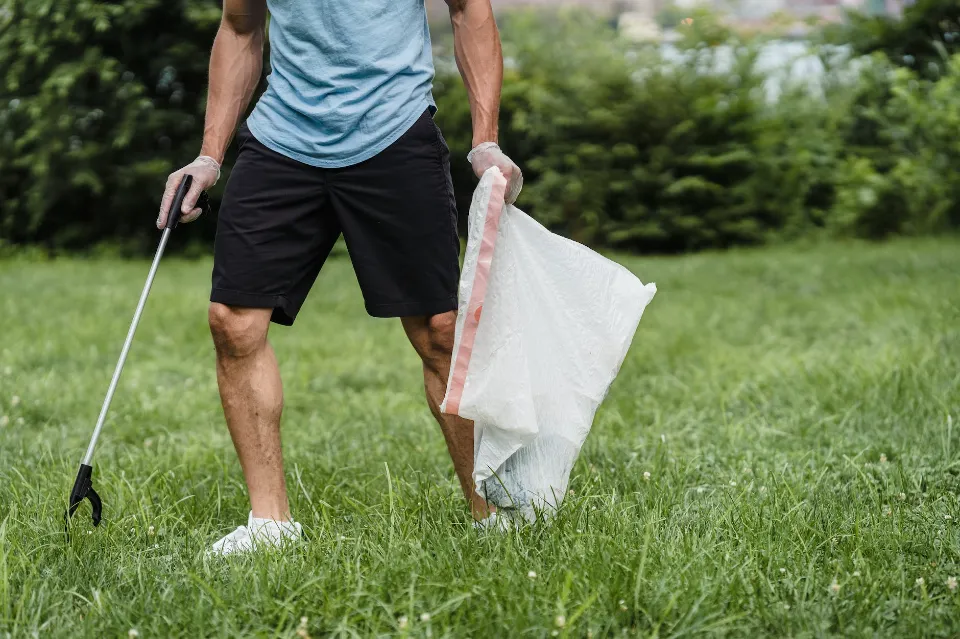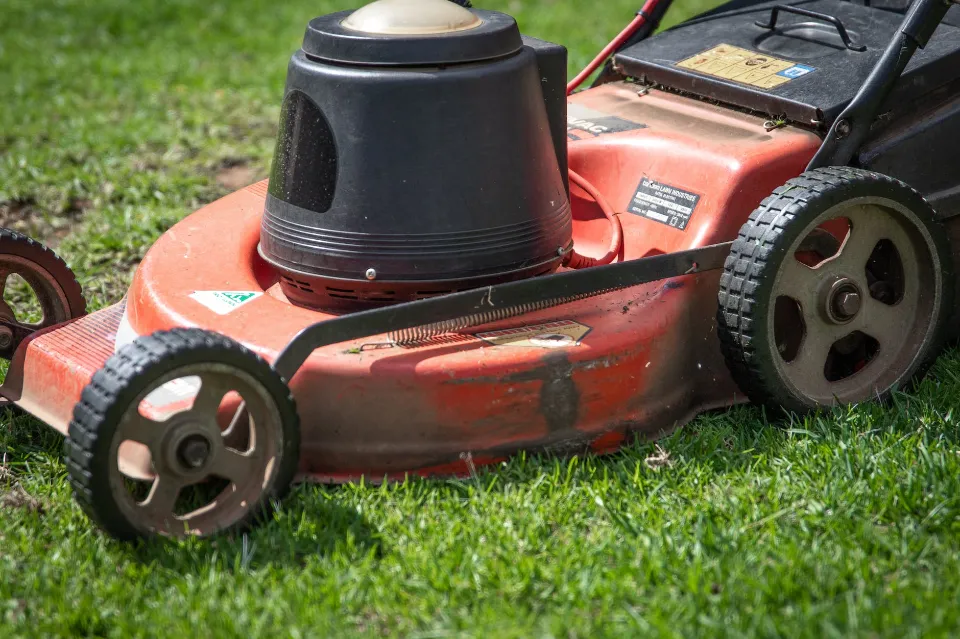In the summer, lawn grub worms are more active and can be found during the warmer months. They can also be referred to as turf grubs, white grubs, lawn grubs, and grubs.
Grub damage to the roots of the grass causes it to thin out, turn yellow, and eventually die. Damage from lawn grubs is typically noticeable beginning in late summer and peaking in the early fall.
Take a look at our list of indicators below to determine whether or not your suspicions about grubs grubbing up your yard are accurate.
Also Read: How Often Should You Apply Sulfur to Lawn – 2023 Guide
6 Signs of Grub Damage in Your Lawn

Uncertain whether grubs are present in your yard?
Here are a few sure-fire signs that will help you identify grub damage:
- Yellowing grass. As grubs consume the roots of turfgrass, the grass turns spongy and yellow. If you tug at it, it will roll back like a carpet.
- The presence of other pest species. Skunks, raccoons, and other digging pests adore grubs and will wreck your lawn in search of them. As costly and challenging to repair as grub damage itself, this harm occasionally occurs.
- Increasing numbers of moths or beetles. If you’ve seen a lot of moths or beetles fluttering around at grass level, you might have a serious grub problem.
- The appearance of drought. If your yard looks drought-stricken, despite regular watering, the problem could be grubs. Grub damage frequently resembles drought, but more watering will not make it go away.
- Brown, patchy grass. It will become brown and patchy before the grass starts to yellow and pull up. This damage will appear in random spots around the lawn.
- The presence of white grubs. Use a spade to cut a square foot section of turf, about 2-4 inches deep. Check the soil beneath the square by pulling it back. Even if you haven’t noticed any damage to your lawn, if you see grubs, you have an infestation.
It can be tough to identify what grub damage looks like, especially since it often resembles other types of damage, like drought.
You can, however, halt grub damage in its tracks by keeping an eye out for these six indicators.
Do I Need Treatment?
You may not need treatment even if you have lawn grubs. Some grubs can be tolerated by a healthy lawn without the need for any lawn treatments.
Checking the number of grubs currently present within a square foot of your grass is the simplest way to determine whether you need to treat your lawn for your grub infestation.
Under 5 grub worms is not a significant infestation and shouldn’t require treatment.
A healthy lawn should be able to tolerate anywhere between 6 and 9 grubs without treatment.
If you have 6-9 grub worms in an already stressed lawn you will likely require treatment.
Your lawn will be severely harmed and require treatment when there are more than 10 grub worms present.
Pull out any grubs you find as you pull up your grass and search for them. After replacing the grass, don’t forget to water it as well.
How to Treat Lawn Grubs?
The ideal time to treat your yard is in the late summer when grubs hatch.
Due to the fact that they will be feeding on the grass roots, newly hatched grubs are frequently found closer to the surface.
This means they will more likely to come into contact with the pesticides. Whilst the grub worms are young, they are also weaker and more susceptible to treatments.
There are two options for treating lawn grubs: an artificial spray or a more organic strategy.
Spray Treatments
Lawn grubs can be controlled with a variety of insecticides.
Fast-acting sprays are available to combat an existing infestation and guard sprays help prevent grubs from laying their eggs, killing any hatchlings before an infestation can occur.
Additionally, you can apply insecticides in the form of granulated sand to your lawn, where the sand will sink into the grass and instantly kill grubs.
Make sure the product is safe to use on the type of lawn you have by reading the instructions on the spray bottle.
Natural Treatments
Nematode introduction is one of the natural ways to get rid of a lawn grub worm infestation.
When grubs are young, the nematode strain Heterorhabitis bacteriophora attacks them by feeding on them before they can cause too much havoc.
Other natural remedies for getting rid of grub worms include neem oil and milky spore, these are put on the lawn and when the grubs eat them, they die before becoming overcoming your lawn and causing an infestation.
2 Conventional Ways to Get Rid of Grubs

If you’re looking for a convenient way to get rid of grubs, you’re in luck.
There are two primary chemicals used to reduce lawn grub populations: carbaryl and trichlorfon.
Both are generally regarded as the only options when there are high grub concentrations in the fall or early spring—before May. Both kill grubs effectively.
According to research, these substances will kill between 20 and 80 percent of grubs when used in September, and between 20 and 55 percent when used in late October.
Here’s a breakdown of each:
Carbaryl
A quick-acting carbamate substance known as carbaryl is efficient at killing grubs. According to recent studies, carbaryl may have a marginally higher kill rate for some grub species than trichlorfon, including the European chafer grub.
10 to 14 days after application, carbaryl starts to kill grubs. Regrettably, research indicates that carbaryl is poisonous to honeybees and other bees, as well as other insects that are beneficial, so it should only be used by specialized pest control companies.
Trichlorfon
In between one and three days, the organophosphate trichlorfon begins to kill grubs. The chemical breaks down after about 7-10 days. Like carbaryl, trichlorfon is most effective when applied in the early spring or fall.
What About Preventative Chemicals?
Both carbaryl and trichlorfon are insecticides used to reduce existing grub infestations. But when used in conjunction with preventative measures, they function best.
Products containing imidacloprid, thiamethoxam, or clothianidin, for example, will reduce 75-100% of lawn grubs when applied in June or July and watered with at least 0.5″ of irrigation immediately after application.
How Do Pest Control Experts Get Rid of Lawn Grubs?
Would you like to get rid of the grubs on your lawn by hiring our qualified team?
Here’s what you can expect from our process:
1. Initial Evaluation
An in-depth analysis of your site is the first step in our grub treatment procedure. To confirm the presence of grubs and identify the species, we’ll visit your property, inspect the soil, excavate some of the bedding areas, and sift through the soil.
We also look at any other lawn damage that animals like raccoons or skunks may have done, as these signs may also point to the presence of grubs.
2. Treatment
We will select a method of treatment once we have established the grubs’ presence. In addition to milky spore fungus and beneficial nematodes, we might also use a liquid systemic insect product.
No matter which choice we suggest, we’ll always make sure you receive the lawn grub treatment that is most appropriate for your requirements.
To allow the product to fully absorb into the soil, we will ask that you stay off the lawn both during and after the treatment.
We’ll run your irrigation system for about 20 minutes to expedite the process. The space can be utilized normally once the lawn has dried.
3. Follow-Up Treatment
Next, we’ll recommend follow-up treatments to kill grubs at different phases of their life cycles. We recommend annual touch-ups because Japanese beetle adults will come to lay eggs every year.

Conclusion
Your yard may sustain serious harm from grubs. Thankfully, you are no longer forced to tolerate those dead, brown patches.
Here at Smith’s Pest Management, our team knows how to get rid of grubs in Bay Area yards, gardens, and flower beds.
We will address your grub issue and revive your lovely, green yard using conventional and environmentally friendly methods.
Lawn Grub Control FAQs
1. When is the Best Time to Treat for Grubs?
When your lawn exhibits increased grub activity, which usually occurs in the early spring and late summer, you should apply grub control agents.
On the other hand, grub prevention agents should be applied during June-July–before the grubs hatch.
2. Will Grass Come Back After Grubs?
To encourage new growth, you will need to reseed the area if the grubs have killed some patches of grass.
We recommend watering it lightly, overseeding it with a quality turfgrass mixture, and keeping pets and kids off it until the grass is 2-3″ tall.
3. How Do I Know If I Have Fungus Or Grubs?
The severity of grub damage increases as the temperature rises. On the other hand, fungus damage thrives in a changing climate.
Check for grubs or fungal damage by grabbing an area of damaged grass and pulling gently. If the roots have completely disappeared, a fungus is probably not to blame.
4. What is the Best Time to Treat for Grubs?
The best time to treat is in the late summer or early fall because that is when the young, smaller grubs are most vulnerable to nematodes. There is also typically a small window for application in the early spring before the grubs grow too large and pupate, but that is a narrower window and can be challenging to time properly.








